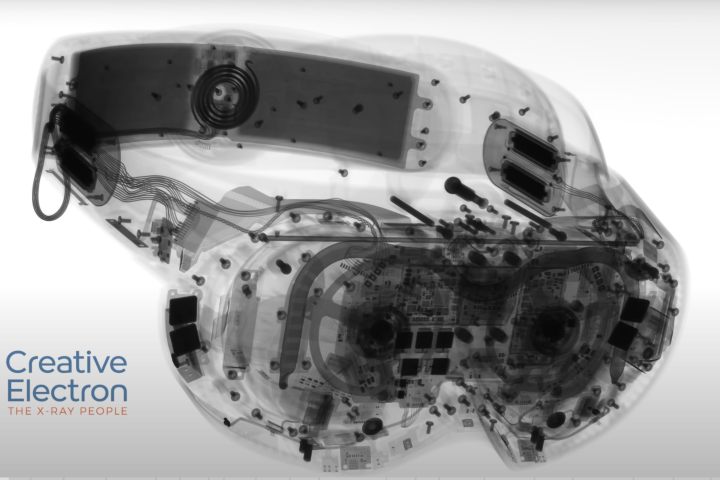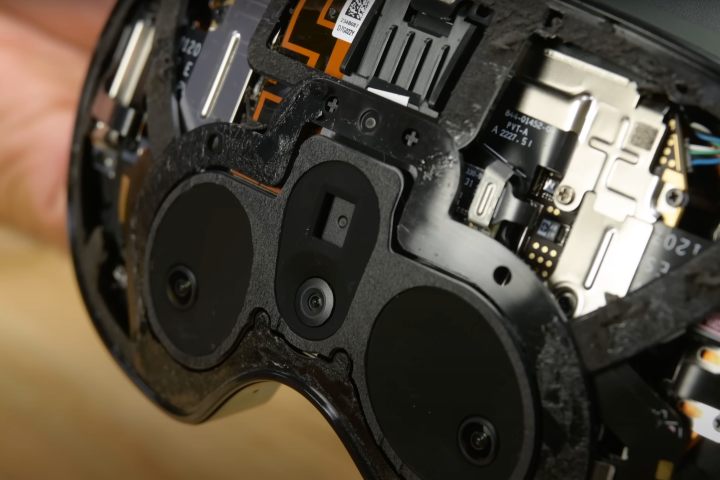The iFixit YouTube channel, which is best-known for disassembling smartphones, turned its focus to the new Meta Quest Pro VR headset, which yielded some interesting surprises.
This is quite a complicated and compact device — featuring multiple inward- and outward-facing cameras, advanced optics, integrated displays, and various sensors — that’s held on your head with a single, circular strap. Meta hasn’t given out complete specifications for the Quest Pro’s components, so a teardown might be the best way to find out what you really get with this $1,500 productivity headset.
The Meta Quest Pro features a 20.58 watt-hour (5,348 mAh) battery, a 44% greater capacity than the 14.3 watt-hour Quest 2 battery. The battery is more easily accessible here since it’s placed at the rear, away from the other electronics, iFixit noted. The challenge, however, might be to order a replacement since curved batteries are uncommon.

There are mysterious flex cables attached to the battery that might be able to detect swelling of the battery. These might be capacitive sensors, iFixit speculated, but didn’t elaborate on why the battery might have this technology. Capacitive sensors are used in touchpads, but can also detect pressure, proximity, and fluids. Perhaps this helps the Quest Pro guide the user toward the best fit or provides a system shutdown in the event of water exposure. We’ve reached out to Meta for clarification.
It was already known that the forehead and rear pads come off easily with a pull and a bit of pressure snaps them back into place. There are inward-facing infrared cameras that track eye and facial movements, as well as stereo speakers mounted in the headband, which provide surprisingly clear sound with good volume.

The faceplate is glossy enough to look like glass, but it’s actually made of plastic, so care should be taken to prevent scratches. With the cover off, there’s an obvious empty rectangle that might have been intended for a depth sensor, which was reportedly canceled just before manufacturing commenced. Andrew Bosworth, Meta’s chief technology officer, commented in an AMA before the launch of the Quest Pro that a depth sensor was unnecessary in modern VR headsets since that capability can easily be handled in software.
Digging deeper into the core of the Quest Pro’s visor, two nearly silent fans are found directly in front of the twin mini-LED displays. These critical components generate quite a bit of heat to provide enough brightness to push through the higher light requirements of pancake lenses. The lenses themselves are made of high-index plastic.
The iFixit team also delved into the secrets of the Quest Pro’s included Touch Controllers, finding that the thumbsticks use potentiometer technology that’s similar to that of the Nintendo Switch. In somewhat of a surprise, the thumbpad is actually a button that can sense depth, allowing grip-force detection that hasn’t been detailed yet by Meta. Each Touch Controller has its own processor and tracking cameras powered by sizable 10.85 Wh batteries. Another detail uncovered is that the stylus sensor isn’t the component responsible for detecting the drawing pressure that Meta claims as a feature of the Quest Pro.
The iFixit team rated the Meta Quest Pro teardown as one of the hardest it has ever completed. Despite this, iFixit praised Meta for using Phillips head screws, a common tool, but stated this won’t be a quickly or easily repairable device.



